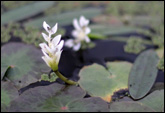FAQ - Plants - Directions for Planting Bog PlantsBog Plants When you receive your plant in the mail, carefully remove it from the box. Try to avoid breaking roots and leaves from the plant, although it should be noted that if the plant is planted properly, it will recover very quickly from the trauma of being shipped, etc. Find a regular nurserymanís pot. Pots that are deeper than wide should have holes in the bottom. Those that are shallow and wide, i.e., trays, need not have holes in the bottom. The reason for the holes is to allow the soil to breathe. If it canít get to some oxygen, it will become anaerobic, which you do not want. Trays need no holes because the soil is able to breathe through its comparatively large surface area. Plants will grow to a size that is directly proportional to the size of the pot, with a given soil mix. Cover the holes in the bottom of the pot with a single layer of newspaper. Pre-moisten the
soil with a small amount of water. Fill the container to within two inches of the top rim. Gently tamp the pot on the ground to remove any trapped air. Cap the top of the potting with sand. DO NOT BURY THE ROOT STOCK OF THE PLANT. If the pond has koi or goldfish in it, stop the soil about 3Ē from the top of the pot, add a thin layer of sand (1/2Ē), then a thick layer of black lava rock. This flies in the face of some recommended planting methods. These would have you use granite gravel of some size or other. We do not like this because the gravel is too heavy, and the plants are not overly willing to grow through gravel. They donít grow through it in nature, so we should not expect them to do so in our ponds. Also, larger stones tend to fall through the soil, leaving the plant as vulnerable to attack from the carp as they were without the stones. The good things about lava rock are that it is lightweight, it is inert, and it has numerous declevities on its surface, which gives the plantís surface roots something to grab on to. This forms a tighter matrix on the soil surface than granite gravel will. And, last but not least, the roughness of the lava rock discourages fish from picking it up. If you have old lava rock from the filter or from the previous planting, use it. We always tamp the lava rock down to tighten it. On top of the lava rock, we add another layer of sand to seal the surface. If there are no koi present, sand alone will do the job. A 2Ē thick layer is fine. Tamp the pot on the ground a couple of times. This squeezes most of the air out of the soil, which ensures that minimal soil will get blown out into the water as the air escapes into the water, and the pot is less likely to tip over in the first few moments after having been lowered into the pond. Merely lift the pot a few inches off of the ground and drop it. Lower it into the pond slowly at first to let more of the remaining air escape, and you are done. |
|||||||
|
Your Account
Gift Certificate
|









